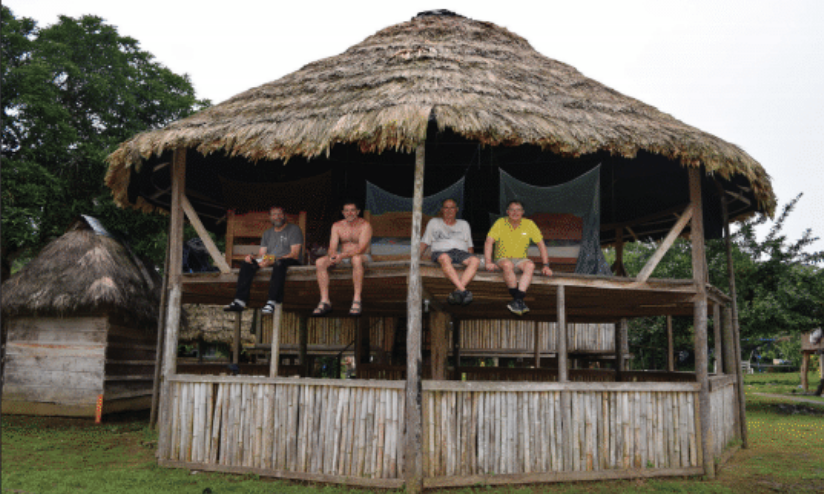
Sean Mickalitis
News Editor
Deep in the Panamanian jungle, among jaguars, bird-eating snakes, and the world’s largest rodent, the Capybara, a large monkey-eating raptor lives high in the trees amid the rainforest mist.
Professors Terry Master, Howard “Sandy” Whidden and Thomas C. LaDuke of the Department of Biological Sciences, traveled to Panama to see the Harpy Eagle in its natural habitat, the lush verdant rainforests of Darién National Park. The professors journeyed to study the eagle and learn about this diverse, pristine ecosystem.
“We’ve talked about taking this trip to Panama for 10 years,” said Master, who is an ornithologist.
The expedition was no leisure stroll through the forest. The professors had many miles to cover over long, dirt roads and up the surging Rio Chucunaque before they stepped foot into the jungle.
“We flew into Panama City, but from there, we traveled to a fairly remote part of Panama. Some of the long-distance travel was done by motorized canoe because there were no roads,” said Whidden, who studies mammals.
Encompassing 1.4 million acres, Darién National Park lies nearly 200 miles south of Panama City, but there was no direct way there, which made the trip a harrowing process for the professors who used many methods to reach their destination.
“It was a six-hour van ride, an hour motorized canoe trip, an hour pick-up truck ride and then a 2.5-mile hike to where we stayed in the national park,” said Master.
Once they arrived at the park, they stayed at the ranger station, where they slept in an open-air bunkhouse. Beds with mosquito nets kept out the bloodthirsty insects and other arthropods.
Their site was primitive. They had to pack-in their food and purify water from a stream, according to LaDuke, who studies reptiles and amphibians as a herpetologist.
The site was so remote and ill-traversed that the visitor log they signed showed there have been less than a hundred visitors over the last few years. There were few, if any Americans, on the log, according to Whidden.
To see the Harpy Eagle, considered to be the most powerful bird of prey in the world, the professors embarked on an additional motorized canoe trip to land belonging to the Embera, the local indigenous tribe.
“The Harpy Eagle is twice as tall as the American Bald Eagle. The talons are as thick as my wrist, and the claws on its talons are as long as a grizzly bear’s,” said Master. “Wingspan-wise they are not that big because they hunt in the canopy and need to be maneuverable to hunt the monkeys and sloths they prefer.”
Although it is found in Central America, the Harpy Eagle’s stronghold in South America. The eagle’s population is unknown but believed to be declining due to loss of habitat, according to a conservation organization called BirdLife International.
The professors also climbed half way up Cerro Pirre, a 5,000 ft mountain near the Colombian border, along with the El Estrangulador trail in oppressive, sultry conditions.
“We walked along a knife-edged ridge where the trail was very steep and rugged,” said Whidden.
Along this trek, the professors found a Solitary Eagle, perched high in a rainforest tree, “a species that has been seen in Panama only 5 times according to a Panamanian field guide,” said Master.
The professors said they also saw other creatures along their trek, including Owl Monkeys, the world’s only nocturnal monkey, Geoffroy’s Tamarins, Capybaras, lizards and toads and a bird-eating snake that was 6 ft. long.
The professors plan to integrate their experience, research, and photos from this trip into their curriculums.
“We have many photos we can incorporate into our classes, especially the Biology of Tropical Ecosystems class we co-teach,” said Whidden. “We can include the stories we have in that and other classes we teach.”
Every spring semester, the professors and ESU students travel to the El Zota biological field station in Costa Rica to study the diverse but impacted ecosystem there. Although Darién National Park is only 700 miles from El Zota, the professors noticed changes in the ecosystem.
“When you work in a forest down in Costa Rica for many, many years you get to know it, and then when you go to another forest, you see the differences,” said LaDuke. “The park had more South American species, and slightly different flora and fauna compared to Costa Rica,” said Whidden.
The professors will use observations from this trip to make such comparisons with El Zota in Costa Rica and will then present the similarities and differences to students in their classes.
More adventure awaits this trio who are already planning their next trip to either the Pantanal, Brazil, Cuba or the Galapagos Islands, where they will continue their research to enlighten themselves and their students.
Email Sean at:
smickiliti@live.esu.edu

